Waffle Stitch Washcloth
Need a little something to keep you busy? What if that little something also offered a bit of comfort? And on top of that, some beauty, too? Yes, that all sounds really good right about now!
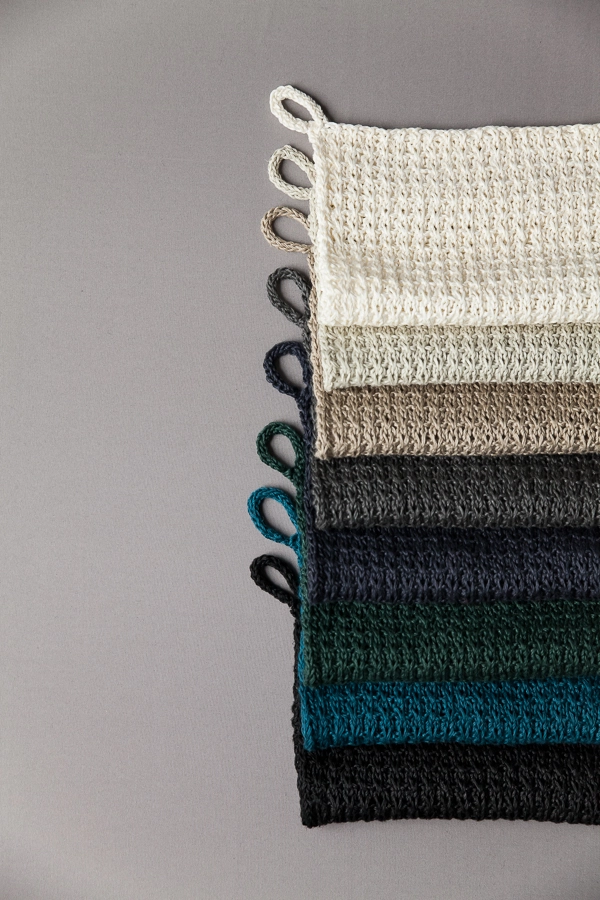
Our Waffle Stitch Washcloths are a wonderful diversion that, in the end, are also a lovely bit of self-care. A delicate texture, a pleasing heft, a spectrum of colors straight from the forest depths or the ocean’s tides… Perfect!
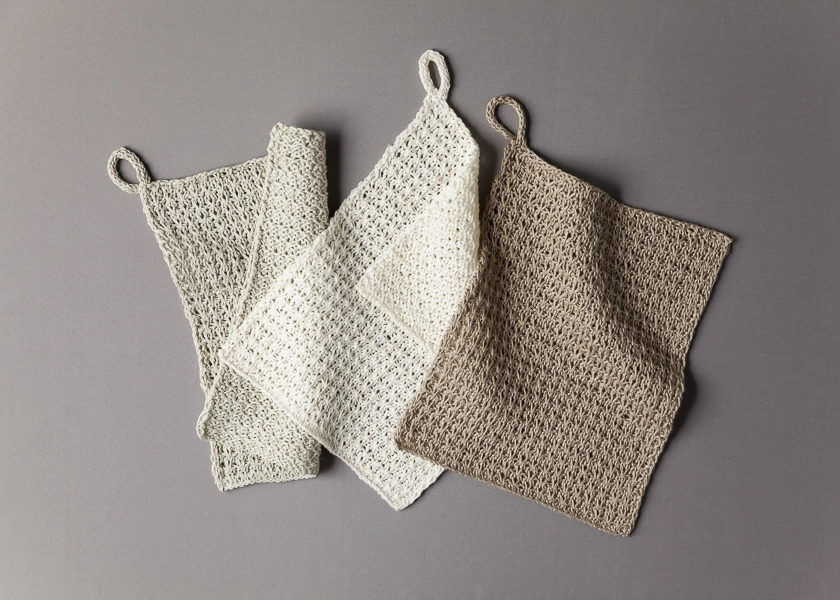
The subtle beauty of our Waffle Stitch Washcloths is rooted in Field Linen, our 100% linen yarn with a nature both raw and refined. Most comforting, it brings to our hearts a feeling of knitting’s past.
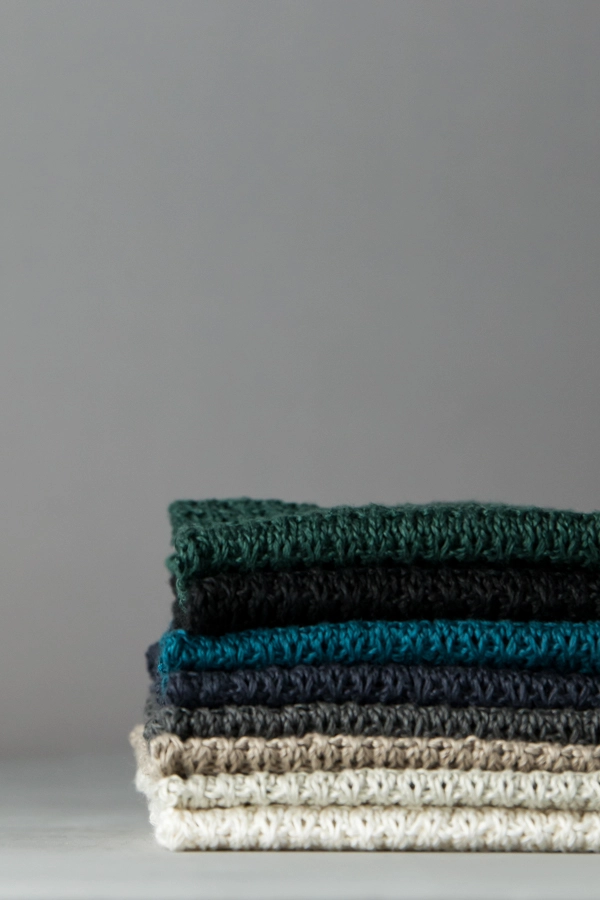
We just added five new colors to the palette, all deep and inky hues that soothe the soul, from Galapagos Teal to Bottle Green. One skein in any color makes four washcloths… Sweet, simple, and so satisfying!
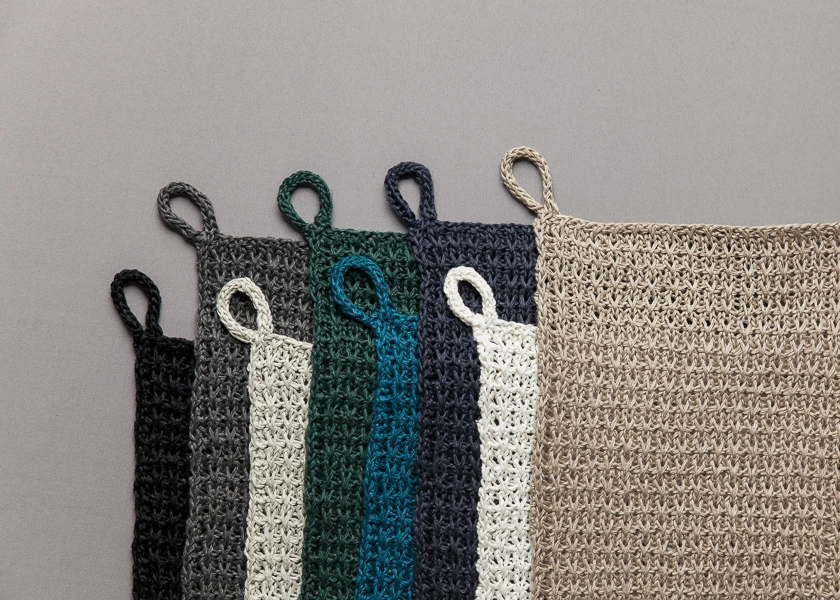
Designed by Purl Soho designer, Jake Canton. Click here to see even more of Jake’s designs!
UPDATE: NOW IN SANTOLINA + A HAND TOWEL, TOO!
JUNE 2022
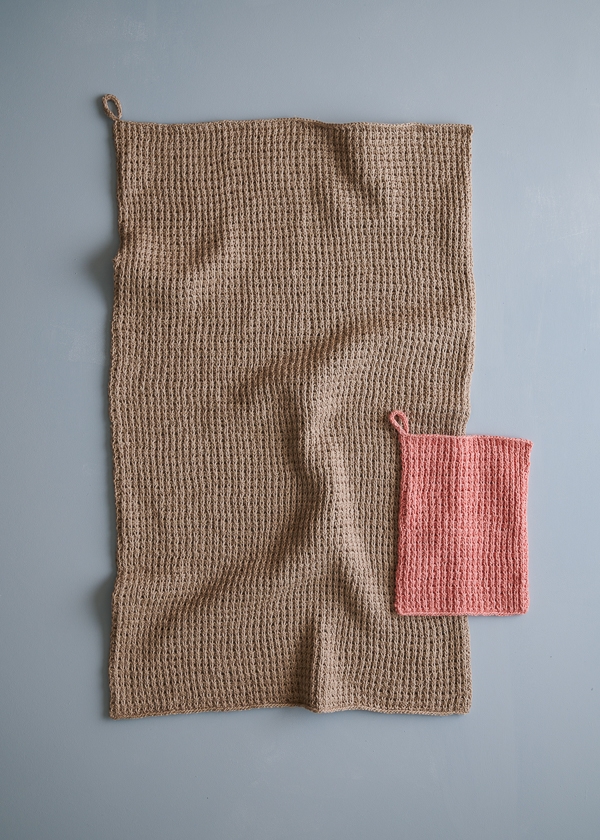
In Santolina, our Waffle Stitch Washcloths, plus Hand Towels, are extra special! A combination of cotton, bamboo, and hemp fibers work together to create a complex and beautiful yarn, a brew of contrasts and complements: Soft but textured. Smooth but gripping. Gently heathered but lustrous. All in all, magnificent!
Share your progress + connect with the community by tagging your pics with #PurlSoho, #PurlSohoBusyHands, #PurlSohoWaffleStitchWashcloth, and #PurlSohoFieldLinen. We can’t wait to see what you make!
Materials
To make four washcloths…
- 1 skein of Purl Soho’s Field Linen, 100% linen. Each skein is 295 yards; approximately 73 yards required for each washcloth. (Note that you use the entire skein to make all four washcloths, so to get four, please make sure your gauge is correct!)
- US 4 (3.5 mm), straight or 16-inch circular needles
- If using straight needles: Two US 4 double pointed needles for I-Cord
Gauge
26 stitches and 52 rows = 4 inches in stitch pattern, blocked
Size
Unblocked Dimensions: Approximately 5½ inches wide x 9 inches long
Finished Dimensions: Approximately 6½ inches wide x 8¾ inches long
Notes
Stitch Multiple
This pattern works over an odd number of stitches.
Slip Stitches
Slip all slipped stitches purlwise.
Pattern
Cast on 43 stitches. We used a basic Long Tail Cast On.
Row 1 (wrong side): K1, purl to last stitch, k1.
Row 2 (right side): Knit to end of row.
Row 3: *K1, slip 1 with yarn in front (wyif, see Notes), repeat from * to last stitch, k1.
Row 4: *K1, slip 1 with yarn in back (wyib), repeat from * to last stitch, k1.
Repeat Rows 1-4 until piece measures 9 inches from cast-on edge, ending with Row 3.
With right side facing you, bind off in 1×1 rib stitch pattern. Here’s how…
Bind Off Row (right side): K1, *k1, pass first stitch over, p1, pass first stitch over, repeat from * to last 2 stitches, k2, leaving 3 stitches on right needle.
Make I-Cord
With the remaining 3 stitches, work an I-Cord for 3 inches, working the last row as follows…
Last Row: K1, knit 2 together, pass first stitch over second stitch and off the right needle. Cut yarn, leaving an 8-inch tail. Pull through remaining stitch.
Thread the tail onto a tapestry needle. Make a loop with the I-cord and weave the tail into the fabric of the washcloth at the base of the I-cord, then weave it through the looped I-cord, and back into the fabric of the washcloth.
Weave in the remaining ends and block as desired.
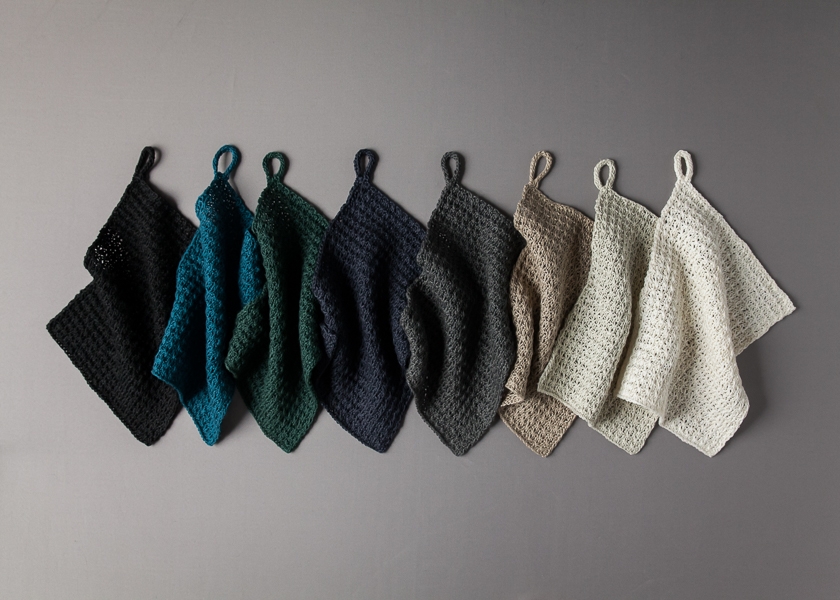

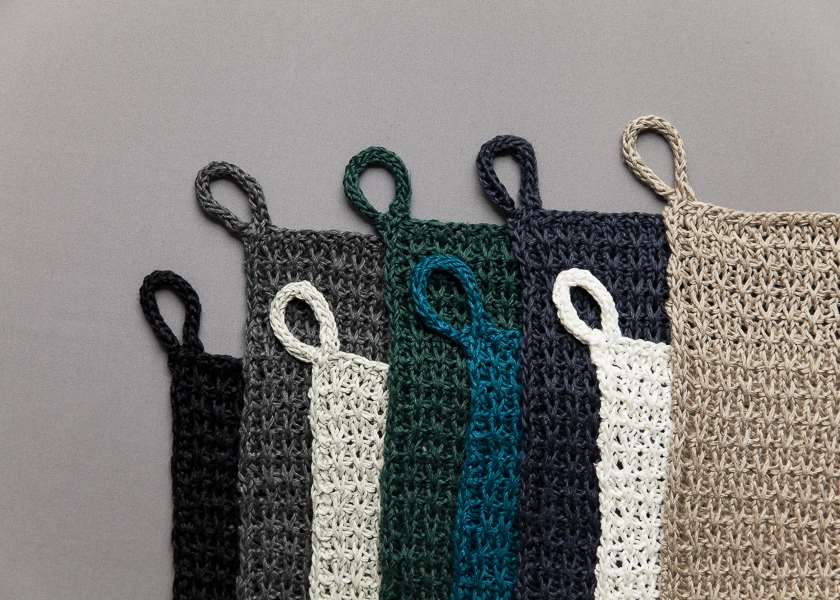
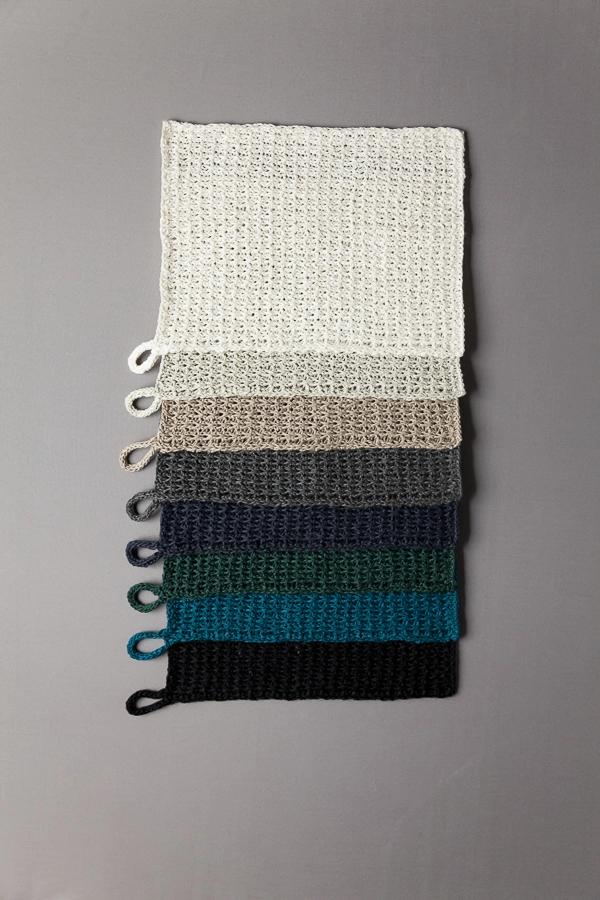
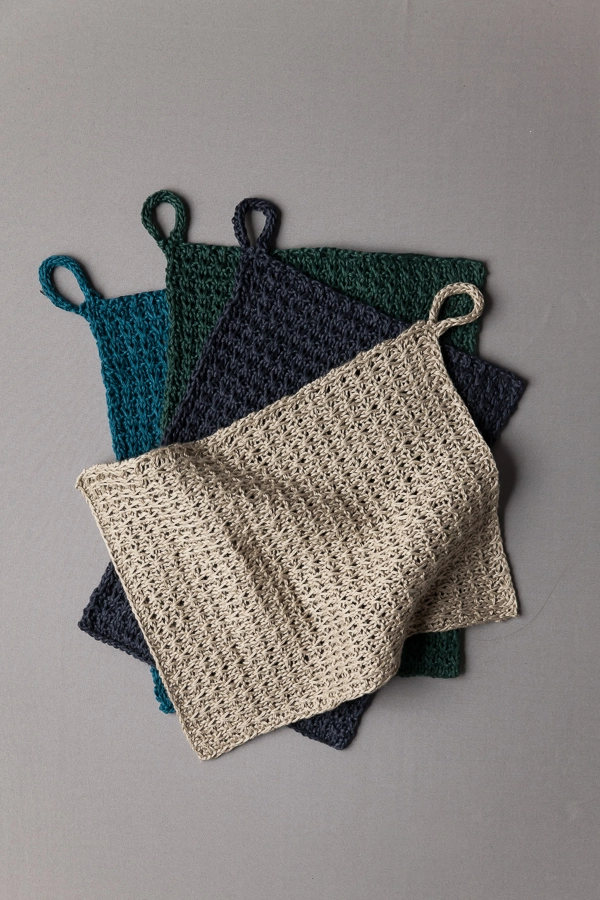
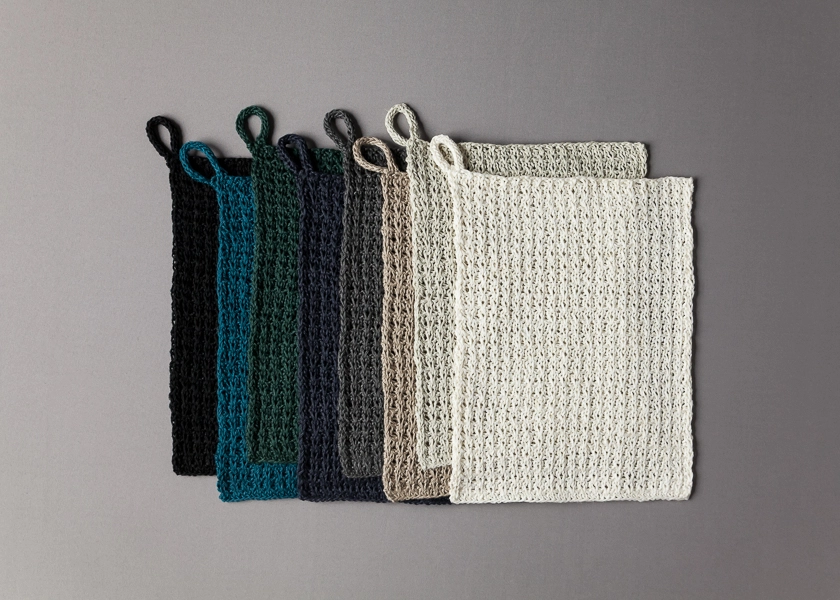


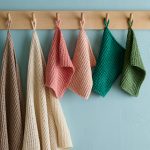
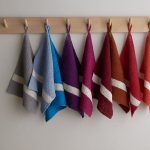
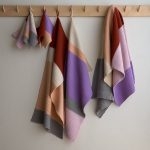
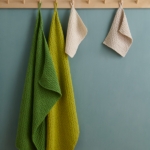
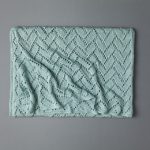
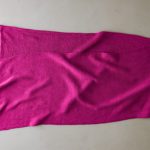
Hello Would this pattern work up also in Purl Soho Cotton Pure? Suzanne
Hi Suzanne,
Thanks for writing! Yes, Cotton Pure would also be a lovely choice for these washcloths! Cotton Pure is a bit thicker than Field Linen, so I’d recommend doing a gauge swatch over an odd number of stitches to decide what needle size works best for you in the stitch pattern. Happy Knitting!
Best,
Cassandra
Hi, I would love to make these wonderful washcloths in the Pure Cotton I already have. Could you please let me know how Pure Cotton would work with this pattern and what adjustments I should perhaps make?
Thanks in advance!
Amanda
Hi Amanda,
Thanks for reaching out! I think Cotton Pure would be a great alternate yarn for this pattern! It is a bit thicker, so you may need to go up a needle size, and perhaps cast on fewer stitches if you want to keep your washcloths around 5 1/2 – 6 1/2″ wide. The pattern is knit over an odd number of stitches, so it will be very easy to make any adjustments in substituting Cotton Pure. Swatching is always a good idea when making substitutions!
Best,
Cassandra
I love this pattern and need something mindless…. but I don’t want to use size 4 needles! Is there a different yarn I can use with a larger needle…. size 7 is about my smallest limit! What do you think?
Hi June!
You might consider trying Cotton pure held double as an alternative for using a larger needle. That would probably get you up to a size 7 or 8 needle, and then you’d want to reduce the number of stitches cast on (it will work as long as it’s an odd number!) to get something in the range of the size here, at 6 1/2″ for the finished washcloth. I hope this helps!
Happy Knitting!
Cassandra
A wonderful idea! But my knitting is poor at best, do you have something similar pattern for the crochet crowd?
Many Thanks! Mary
Hi Mary,
Thanks for reaching out! We have two crochet patterns for washcloths – the Mother’s Day Washcloths and our Tunisian Crochet Washcloth pattern. They’re both written for yarns a bit thicker, but I think they could be adapted easily to use just about any yarn! I hope this helps!
Best,
Cassandra
Would one skein of Field Linen be enough to make a dish towel instead of four washcloths? I have made the heel stitch towel in Field Linen, and one dishtowel requires one skein.
It just seems like the waffle stitch requires less yardage. Is that correct?
Hi Jessica,
Thanks for asking! The waffle stitch is a bit more open than the heel stitch, and is knit on larger needles, so you’d get a little more mileage out of waffle stitch. We used a bit more than one skein for our Heel Stitch Hand Towel, but if you were able to get a towel out of one skein, I’m sure that you could do the same with a waffle stitch version!
Happy Knitting!
Cassandra
I love this pattern. I have two questions. I don’t know how to do i-cord, so could I just finish it off without the loop? And, I often give washcloths as gifts, sometimes to men who might prefer a bit bigger size. Should I just cast on more stitches as long as it is an odd number? How would I make it wider also? Thanks!
Hi Jenice,
So nice to hear that you’re excited about our newest project! We do have a great tutorial on making I cord, here: I-Cord Tutorial, which might help. And of course you can also skip the I-cord and the loop if you wish! And you’re correct, you can just cast on more stitches, as long as it’s an odd number, and knit more rows to increase the size of the finished washcloth. Hope this helps!
Best,
Cassandra
I-cord looks more difficult than it is. With the tutorial to guide, you should have no problem mastering it. You do need double point needles though. Good luck!
How do you prevent your work from curling up?
Hi Connie,
Thanks for writing in about this! All of our samples have been wet blocked after finishing, and linen blocks out very crisply. If your gauge is off, that also sometimes contributes to curling, but that too often blocks out neatly. I hope this helps!
Best,
Cassandra
This is maybe not the place to put this comment but do you have any sweater patterns with this waffle texture? I love it!
Hi Tiffany,
Thanks for asking about this! You can actually browse all of our knit garments here: . The first one that came to mind when I read your questions was the End To End Pullover, which has a simple garter stitch texture. You can take a look at it here: https://www.purlsoho.com/create/2019/05/12/end-to-end-pullover/. I hope this helps!
Best,
Cassandra
Would this material be okay for drying dishes if I enlarged the towel to make into a dish towel for drying dishes?
Hi Sherri,
Thanks for asking about this! Linen is actually more absorbent than cotton, and makes a great dish towel or hand towel. Waffle stitch would work, but we also have another pattern that you might consider for a Field Linen towel – . Lots of ideas to choose from, and linen is such a great summer knitting project!
Best,
Cassandra
Would these washcloths be too scratchy, lumpy or skimpy if knit with your “lantern” cotton/linen yarn? Thanks for replying and be well.
Hi Eve!
Thanks for asking about this – we actually have a pattern for a “dishcloth” (but it could also be a washcloth!) written specifically for Lantern. They’re called Pebble Dishcloths and you can find the free pattern here:
Lantern is quite a bit heavier than Field Linen, and has a thick/thin texture that stands out really beautifully in very simple knits like garter stitch or stockinette. I hope this helps!
Best,
Cassandra
I don’t understand how you make cord out of the remaining 3 stitches. Is there a pattern for that?
Hi Gerry,
Thanks for asking about this! We have a tutorial for I-cord here: . I hope this helps!
Happy Knitting!
Cassandra
Hello-
I have a few skeins of LANTERN. I think it’s a thicker yarn than the Field Linen. Can I use it as a substitute? If so, how would I adjust the pattern to use LANTERN
Thank you for the advice!
Hi Irene,
Lantern is quite a bit different than Field Linen, both in thickness and in texture. Lantern has a bit of thick-and-thin to it, while Field Linen is smooth and much thinner overall. We do have a dish cloth/wash cloth pattern specifically written for Lantern, though! The Pebble Dishcloths pattern would work well as a wash cloth as well. I hope this helps!
Best,
Cassandra
I am confused, this sliped stitch is called Linen Stitch, at least in the literature that I know. The Waffle Stitch doesn´t have slipped stitches… Wonderful material, thanks for share.
Hi Paty,
I’m so glad you like the project! There are multiple names for so many stitches – so much of knitting was passed hand-to-hand before anyone started printing pattern books and names. We chose to use “waffle stitch” for this one – happy knitting!
Best,
Cassandra
Quel numéro d’aiguilles pour réaliser les gants de toilette en lin au point de gaufre ? Merci
Hi Annick,
Thanks for asking! We used a US 4 (3.5mm) needle for the washcloths. Happy Knitting!
Best,
Cassandra
Love these! I’m thinking of making these for xmas gifts, and am just wondering what the care instructions would be? Machine wash/dry? The recipients aren’t going to be blocking them, so will the edges be rolled? How will they hold up? TIA!
Hi Sharla,
Thanks for asking about this! We recommend washing Field Linen on a delicate cycle with cold water and then laying flat to dry. Linen yarn is very durable and should hold up for years! It also dries very quickly, and doesn’t require actual blocking for a washcloth project. I hope this helps!
Best,
Cassandra
Great, thank you!!
Thank you for the above and directions for the cord – brilliant!!!
I am not sure what (wyib) means and could not find your notes.
Would love to order your Field Linen but the usual problem of Customs makes it too expensive.
Lots of love and hope you have time to reply.
Jean (UK)
Hi Jean,
Thanks so much for reaching out! “wyib” is shorthand for “with yarn in back.” There are some parts of this pattern that will specify wyif/with yarn in front, as well. The placement of the yarn when slipping the stitches is what helps create the unique texture in these washcloths. We also have a handy guide to abbreviations here: I hope this helps, and please feel free to reach out with any other questions you may have!
Best,
Cassandra
Thank you for the above and directions for the cord – brilliant!!!
I am not sure what (wyib) means and could not find your notes.
Would love to order your Field Linen but the usual problem of Customs makes it too expensive.
Lots of love and hope you have time to reply.
Jean (UK)
Hi Jean,
Thank you for writing in! I’m so glad to hear you’re enjoying this pattern and would be happy to help solve this little mystery! Wyib is an abbreviation which means ‘with yarn in back’. This and wyif (‘with yarn in front’) help you make sure your yarn is in the right position when slipping a stitch. In the Waffle Stitch Washcloths, you’ll always want to be slipping your stitch purlwise whether its wyif or wyib. Our Knitting Abbreviations page is a helpful resource as well if you come across any unfamiliar terms in your future knitting. I hope that helps!
Best,
Gaby
Are these for use on the face/body, or dishes? Thanks!
Hi Ann,
Thank you for writing in! We designed these for personal use, but feel free to use these on your dishes if you’d like. Linen is highly absorbent so it works in a variety of household settings!
Happy knitting!
Gaby
Is field linen yarn soft for use on sensitive mature skin? Thank you.
Hi Denise,
Thanks for asking about this! Linen yarns tend to be quite “crisp” as they start out and will soften considerably over time. For very sensitive or delicate skin you might want to consider using our Cotton Pure instead of linen. I hope this helps!
Best,
Cassandra
For the waffle stitch washcloth pattern I’m missing something. If you follow the pattern as written, rows 3 and 4 are slipping the exact same stitch so that it doesn’t get knitted ever!? I shifted it so I’m knitting the slipped stitch & like the pattern but it’s a little different than the picture, and it’s bugging me that I can’t figure this out. I’m a pretty advanced knitter, so I just don’t see what I’m missing here. Thank you so much for your help.
Hi Isabella,
Thanks so much for your question! This pattern is a 4 row repeat. After completing rows 3 and 4, You would then begin to repeat with row 1 again. All the slipped stitches will be purled in this row. I hope this helps!
Happy Knitting
Jessica
Hi Jessica- thank you so much. I think seclusion got to me!! Of course it’s a 4 row repeat- geez. I’ll excuse it to the pattern not being printed which is always my preference. Thanks again.
Ha, Ha, I did the exact same thing! So glad you asked the question! That straightened me right out!
Hello,
The note says all slip stitches are down as purl ( washcloth pattern)
Then clearly in the pattern it mentions two kinds of slip stitches
One with yarn in front the other with yarn in back.
From the start this is confusing to me
Please clarify
Hi Jules,
Thanks for writing in about this! Sometimes the knitting terms can be a little confusing, for sure! The reference to the way the stitches are slipped is constant, the only difference is the position of your yarn as you slip them – “wyib” for with yarn in back and “wyif” for with yarn in front. The slipping is done the same throughout the pattern. I hope this helps – please let me know if you have any more questions, I’m always happy to answer!
Best,
Cassandra
I am a beginner, is there an easier stitch I can do with this linen yarn? Thank you
Hi Sharon,
Thanks for writing in! The Waffle Stitch is surprisingly easy, so even as a beginner, I would suggest giving it a try – it might turn out to be a nice skill-builder for you! If you would like something even easier, our Heel Stitch Hand Towel is knit in a very simple two-row repeat, or you could even just cast on the same number of stitches as we did here and knit in plain garter stitch!
Happy knitting!
Julianna
Hi there,
For Row 3 — it says to slip with yarn in front (and I understand all slips are purlwise) — the thing I am not sure about is when I go to knit the next stitch — do I flip the yarn to the back? Or am I keeping the yarn in front for this whole row?
Thanks!
Hi Amy
Thanks for reaching out! You are correct that after you slip the stitch, you will move your yarn between the needles to the back ready to knit the next stitch. This float of yarn helps create the waffle design. I hope this helps!
Happy Knitting
Jessica
I am following the instructions to the “t”, yet my project looks nothing like the pictures. Will the look change once it’s wet blocked? Maybe I need to knit tighter?
Hi Sandrina,
Thanks for writing in! It’s really hard to say without seeing your work. Have you tried measuring your gauge and comparing it to ours? It can be tricky to knit evenly in linen due to how inelastic it is, so it’s quite common for the appearance of your knitting to improve with blocking as your stitches even out, but the basic structure of the stitch pattern should still be apparent, even if your gauge doesn’t look as regular as usual. I would recommend measuring your stitches per inch to see if you are matching our gauge of 26 stitches and 52 rows to 4 inches in pattern, and perhaps putting your stitches on a piece of scrap yarn and blocking what you have knit so far to see how it turns out. You can always send us a picture of your work to customerservice@purlsoho.com if you still aren’t sure!
Best of luck, and I hope that helps!
Julianna
Hi
My edges aren’t the tidiest, is that right? Yours seem very very neat on the picture. Any advice?
Thank you
Hi Cris
Thanks for the question! We wet blocked our samples and this definitely smoothes the edges out! You can also try knitting the first stitch a little tighter to see if that helps. If, in the end, you’d like an even neater edge, a single crochet or slip stitch edge , or an attached i cord would do the trick. I hope this helps!
Happy knitting
Jessica
Wondering how your Linen Quill would work? There are more colors! Thanks
Hi Maggie,
Thanks for reaching out! Although I love Linen Quill, unfortunately, it isn’t a great choice for a washcloth. Wool and alpaca aren’t as absorbent as cotton or linen, and since Linen Quill isn’t superwash, it would felt when subjected to the wear and tear a washcloth goes through. Instead, I would recommend our Cotton Pure! It is fantastically durable and washable, and comes in a beautiful color palette!
I hope that helps, and happy knitting!
Julianna
Hi all, thank you for being there! I have misplaced the pattern that you sent out about a month ago? Dishclothes using the Linen Field (the Galapagos Teal was out of stock, then i missed it when it came back and am trying to order now, too, back on waiting list). I cannot find the pattern, I do remember at one time there was a bundling option (not available now) if that helps. It came in an email and I am normally so good about keeping those. Thanks for your time!
Hi Karly,
Thanks for getting in touch! It sounds like you might be mixing up a few of our emails that came out around the same time! The Waffle Stitch Washcloth above is our most recent Field Linen washcloth which we released a little over a month ago, but did not offer as a bundle. Shortly after that, we released our Knit Linen Market Bag, also in Field Linen in the color Galapagos Teal, which did sell out quite quickly! Just a few weeks ago we sent out an email about our Pebble Dishcloths in Lantern, a linen and cotton blend, which we offered in bundles when we original released the yarn and pattern a few years ago.
I hope that clears everything up!
Julianna
Can I make this with your pure cotton?
Hi Sheila,
Great question! Cotton Pure is a little thicker than Field Linen, but you could certainly use it with a few modifications! I would suggest knitting a gauge swatch in the waffle stitch pattern using a US 5 or 6 needle. You can then multiply your stitches per inch by 5.5 inches and round to the nearest odd number to determine how many stitches to cast on!
I hope that helps, and happy knitting!
Julianna
any chance this pattern can be written for the Cotton Pure Organic yarn??
Hi Dina,
Thanks for reaching out! I’m happy to help you modify the pattern to use Cotton Pure! To get started, you will need to knit a gauge swatch in pattern using a US 5 or 6 needle. You can then measure your stitches per inch, multiply that number by 6 inches, and round to the nearest odd number to determine how many stitches to cast on. After that, you can follow the rest of the pattern as written!
I hope that helps, and happy knitting!
Julianna
Hello!
I completed four wash cloths from one ball of yarn and have left over. My concern is that you mentioned we should have just enough to make 4 wash cloths from one ball of yarn. Before starting on another ball, I want to be sure I am not doing something wrong?
Thank you.
Hi Punum,
Thanks for reaching out! How much of the yarn is left over? It could be that your gauge was slightly off causing the washcloths to come out a bit smaller than what we estimate in the pattern. If you are happy with the size they are when finished, I don’t think that is a problem and you now have possibly enough leftover to make another!
All the best,
Gianna
I read through as many comments as I could to see if my question was answered before I asked. 🙂
When slipping a stitch (wyib or wyib), is it knitwise or purlwise?
Thank you for a lovely pattern and website!
Hi Maria,
Thanks for reaching out and for your kind words! You can find that information under the NOTES section of the pattern! For these washcloths all slipped stitches are slipped purlwise!
All the best,
Gianna
Hi, I am confused by the gauge–why is it 26 stitches by 52 rows when the pattern calls for an odd number of stitches? I started this project and 43 stitches cast on size 4 needles and my knitting didn’t seem nearly as tight as the photos–In fact it was really quite loose and was definitely wider than 6″…so, I thought I would do a knitting swatch to figure my gauge…–so I should cast on 26 stitches and knit 52 rows? As you can tell I don’t always do a sample gauge before I knit. Thanks for your help.
Hi Mary,
Thanks for reaching out! So the gauge of the pattern doesn’t necessarily have anything to do with the stitch multiple. The gauge is the measurement of stitches per inch, so if you divide 26 stitches by 4 you will get 6.5 stitches per 1″ this is what you knitting should measure in at. You need an odd multiple of stitches in order for the stitch pattern to work, but if your gauge is accurate it should measure in at 26 stitches for every 4 inches (or 6.5 stitches for every inch.) I recommend looking at out All About Gauge tutorial, it will walk you throughout the gauging process in more detail! I would also recommend making a swatch bigger than 4″ so that you can get an accurate stitch count. I suggest a 5″ swatch so cast on 33 stitches (6.5 x 5= 32.5 rounding up to 33 for an odd stitch number.)
I hope this clarifies things for you, happy knitting!
Gianna
Hi! I recently got a ball of hemp yarn, after seeing a beautiful washcloth on display. Absentmindedly, I didn’t look at the pattern name, and bought the ball without a clear pattern in mind. After looking through my saved patterns, I found this one! Would I be able to substitute hemp for the linen in this? Maybe if I just get gauge? Thanks!
Hi Hannah,
Thanks for reaching out! Yes, I think this would be a great pattern for your hemp yarn! As you said, I’d just make sure to check your gauge before beginning, but I think it will be a great fit.
Happy Knitting!
Kelsey
Hi,
I just wanted to make sure I’m doing the pattern correctly. Row 3, I’ll K1 slip one for the whole row bringing the yarn to the front before I slip and then back to knit.
Thanks!
Trisha
Hi Trisha,
Thanks for writing in! Yes, that is correct! You will knit 1 then slip 1 with the yarn in front, then bringing the yarn back to knit. You will repeat that for the entire row!
Happy knitting!
Gianna
Hi! I love these wash cloths, but I need some instruction on Row 4 in the 4 pattern repeat. I followed the directions by Knitting the 1st st, but then the yarn is already in the back ( wyib) when I slip the next stitch purlwise. After that, the yarn never has to be moved to the back because it’s always in the ‘back’ position across the row. What am I doing wrong?
Hi Marsha,
Thanks for reaching out! You aren’t doing anything wrong, if the yarn is already in the back that is totally fine. For row 4 the important part is when you slip the stitches that the yarn should be in the back of the slipped stitch, not in the front as it is in row 3.
I hope this clears things up!
Gianna
Hi Gianna! Thank you for your response. You confirmed that my interpretation of the instructions was correct. I love how you stay on top of your email questions! Yay, to everyone at Purl Soho!
Hi, I love this pattern but would like to make a scarf or wrap in Blackbird Linen instead of Field Linen. If you could suggest what needle size and how many skeins I would really appreciate it. Thank you always!
Hi Pam,
Thanks for reaching out. We recommend sizes US 3 – 5 needles for Blackbird Linen! Can you let me know the dimensions you’re planning on making the scarf or wrap? That will make it easier for me to give an accurate estimate of how many skeins you’ll need to make it.
Thanks!
Lili
Hi, I’m a bit confused with this pattern. I’ve cast on the right number of stitches and am using the right size needles. With row 3 when I slip 1 with yarn in back and then row 4 when I slip one with yarn in front I end up with two slipped stitches in a row. Is that the correct pattern? It seems like the slipped stiches should alternate…please advise!
Thanks!
Hi Rose,
Thanks for reaching out. I can confirm that the pattern is correct as written! This pattern is a 4-row repeat, so after completing Rows 3 and 4, you will begin the repeat on Row 1 again. All the slipped stitches will be purled in this row. I hope this helps clarify things!
All the best,
Lili
Thank you so much for this pattern! I would like to make it a bit bigger to be a dish towel instead of a dishcloth – what would you recommend for a multiple to cast on to match the size I desire? I’m just wanting to play around with it 🙂
Hi Jullianna,
Thanks for reaching out! The dimensions of the Waffle Stitch Washcloths can be easily adjusted by casting on an odd number of stitches. Casting on 43 stitches will create a 5 1/2 inch wide washcloth, so depending on your gauge you can cast on 87 stitches for an 11″ wide dish towel.
I hope this helps!
All the best,
Carly
Hi Lili,
Thank you for getting back to about making a scarf in Blackbird Linen. I am not sure what size would be best maybe 10 “or 15″ wide X 70” long. I love the dark pink in Blackbird Linen and love this Waffle Stitch pattern. How many skeins and how many stitches to cast on? Thank you for helping me modify this pattern. I have been trying to choose a good pattern for this linen and an easy one too. Thanks again.
Hi Pam,
This is a wonderful stitch pattern to adapt for a scarf! I’d say that you would need 7 skeins of Blackbird Linen for a 15″ wide scarf and 6 for a 10″ wide scarf (both 70″ long).
To figure out your cast-on number, you will want to first knit a gauge swatch in pattern. Once you know how many stitches you are getting per inch, you can multiply that number by the width that you would like and cast on the nearest odd number. Then you can follow the pattern as written!
All the best,
Lili
Thanks so much Lili, your advise is so helpful.
I really appreciate it! I am excited to start this new scarf and think the pattern will look so cute. Thanks again!
You’re very welcome, Pam!
All the best,
Lili
Lovely!
How would this stitch work as a scarf using baby alpaca/fine merino wool/mulberry silk blend? Already have the yarn, specific for a gift, but am struggling to find an appropriate stitch design for a middle aged, old fashioned, not fussy man. Also will it curl? As I do not have extra yarn to play to add enough width to make curling un noticable.
Hi Andaluna,
Thanks for reaching out. This stitch pattern will definitely work as scarf using any yarn! While some people have noticed that the edges curl slightly, that is generally solved through wet blocking. Alternatively, you can add some ribbing or garter stitch to each edge so that it won’t curl at all, without altering the size of the scarf. Hope this helps!
All the best,
Lili
Hi!
I’m knitting the washcloths for my daughter’s second “baby sprinkle” and ended up using a larger needle (sz US 5) to get the gauge right. My question is about blocking. I can see from your instruction photos that the samples are blocked. Will they need to be blocked every time they are washed?
Thanks!
Debbie
Hi Debbie!
Thank you for writing in. Since Field Linen is safe to machine wash and lay flat to dry, washing and drying them in this method will be the same as blocking them, so there is no need to repeat this process and block them twice for each wash! Machine washing them, and laying the washcloths flat to dry will be just fine to help them maintain their shape.
I hope this helps, and congratulations to your daughter!
All the best,
Margaret
Hello, thank you so much for this pattern! I have one clarifying question… row one is knit on the wrong side and row 2 is knit on the right side, so do I continue knitting the rest of my rows on the right side or do I alternate with odd number rows knit on the wrong side and even number rows knit on the right side?
Thank you!
Hi Christina,
Thanks for reaching out. In this pattern, all odd-numbered rows are wrong side rows, and all even-numbered rows are right side rows! Hope this helps clarify things!
All the best,
Lili